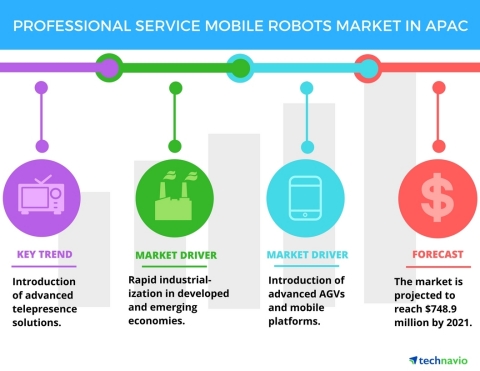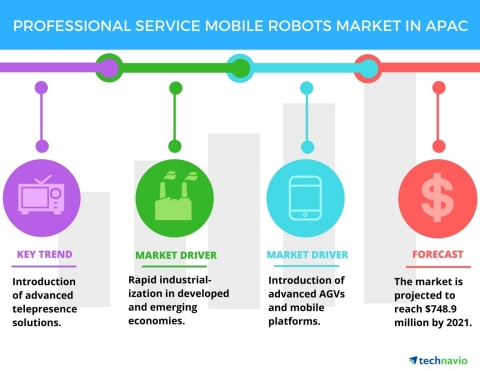LONDON--(BUSINESS WIRE)--Technavio’s latest market research report on the professional service mobile robots market in APAC provides an analysis of the most important trends expected to impact the market outlook from 2017-2021. Technavio defines an emerging trend as a factor that has the potential to significantly impact the market and contribute to its growth or decline.
Raghav Bharadwaj Shivaswamy, a lead analyst from Technavio, specializing in research on robotics sector, says, “The professional service mobile robots market in APAC is expected to grow at a CAGR of more than 21% during the forecast period owing to an increase in government initiatives to fund for innovations in the robotics sector. The rise in the aging population is anticipated to create demand for robots to substitute human personnel in sectors such as the healthcare, hospitality, and tourism sector.”
This report is available at a USD 1,000 discount for a limited time only: View market snapshot before purchasing
Buy 1 Technavio report and get the second for 50% off. Buy 2 Technavio reports and get the third for free.
The top three emerging market trends driving the professional service mobile robots market in APAC according to Technavio research analysts are:
- Increasing potential of telepresence robots
- Adoption of data analytics to improve customer experience
- Technological improvements in machine vision systems
Looking for more information on this market? Request a free sample report
Technavio’s sample reports are free of charge and contain multiple sections of the report including the market size and forecast, drivers, challenges, trends, and more.
Increasing potential of telepresence robots
Telemedicine is a division of medical practice, in which the diagnosis, evaluation, and treatment of a patient by doctors are performed remotely. Physicians who are located offsite instruct medical technicians to examine and treat patients in real-time, via telepresence solutions.
Advanced telepresence solutions, such as telepresence robots, can enable physicians to circumvent the barriers of distance and obtain the desired view of the patient as if the patient was in the physician's clinic. Thus, the examination details that are key to an accurate diagnosis will remain uncompromised, enabling the physician to precisely instruct the technicians regarding treatment and surgical procedures.
“As healthcare facilities in APAC see improvement, it is expected that more vendors will enter the market to capitalize on the advantages of these robots for the medical and healthcare sectors,” says Raghav.
Adoption of data analytics to improve customer experience
As the market is gaining traction, key players in the market are devising strategies to provide a more holistic customer experience to end-users adopting professional service mobile robots. Tracking real-time data can be helpful in providing preventive maintenance and reducing response times. Data analytics can also ensure that issues are addressed before they turn critical. If companies capitalize on the vast amount of data available and channelize the opportunities driven by customer data analytics, it is expected that they will see a surge in revenue and customer loyalty.
Also, robots are increasingly being equipped with sensors that can help in predicting wear and tear of robot parts. Vendors are also providing cloud-based apps to customers and service personnel, through which they get alerts about service and replacement requirements.
Technological improvements in machine vision systems
Vendors in the market are consistently working on advancing their product offerings through the use of better machine vision systems in mobile robots. A major field of innovation and improvement which will affect the capabilities of autonomous mobile robots is light detection and ranging (LiDAR). LiDAR sensors are increasingly being used in autonomous mobile robots as they offer a long range along with precision. However, LiDAR sensors also have drawbacks. They can operate only in a single fixed plane. To solve the challenge, vendors are incorporating technologies such as sensor fusion, which combines data from multiple sensors such as shorter-range 3D cameras to complement LiDAR sensors.
Browse Related Reports:
- Global Metal Fabrication Robots Market 2017-2021
- Global Rehabilitation Robots Market 2017-2021
- Global Security and Law Enforcement Robots Market 2017-2021
About Technavio
Technavio is a leading global technology research and advisory company. Their research and analysis focuses on emerging market trends and provides actionable insights to help businesses identify market opportunities and develop effective strategies to optimize their market positions.
With over 500 specialized analysts, Technavio’s report library consists of more than 10,000 reports and counting, covering 800 technologies, spanning across 50 countries. Their client base consists of enterprises of all sizes, including more than 100 Fortune 500 companies. This growing client base relies on Technavio’s comprehensive coverage, extensive research, and actionable market insights to identify opportunities in existing and potential markets and assess their competitive positions within changing market scenarios.
If you are interested in more information, please contact our media team at media@technavio.com.




